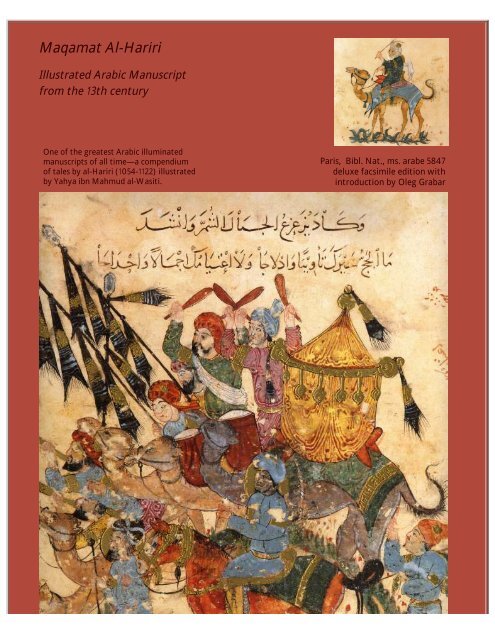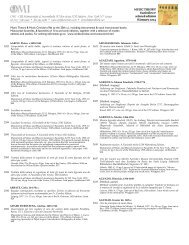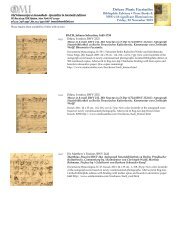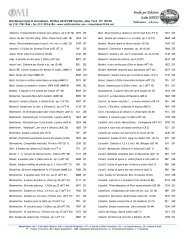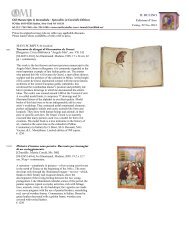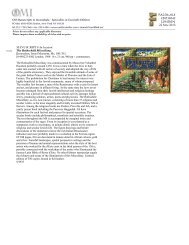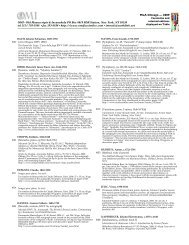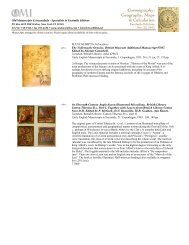Maqamat Al-Hariri 13th c. Illustrated Arabic Manuscript - OMI - Old ...
Maqamat Al-Hariri 13th c. Illustrated Arabic Manuscript - OMI - Old ...
Maqamat Al-Hariri 13th c. Illustrated Arabic Manuscript - OMI - Old ...
Create successful ePaper yourself
Turn your PDF publications into a flip-book with our unique Google optimized e-Paper software.
<strong>Maqamat</strong> <strong>Al</strong>-<strong>Hariri</strong><br />
<strong>Illustrated</strong> <strong>Arabic</strong> <strong>Manuscript</strong><br />
from the <strong>13th</strong> century<br />
One of the greatest <strong>Arabic</strong> illuminated<br />
manuscripts of all time—a compendium<br />
of tales by al-<strong>Hariri</strong> (1054-1122) illustrated<br />
by Yahya ibn Mahmud al-Wasiti.<br />
Paris, Bibl. Nat., ms. arabe 5847<br />
deluxe facsimile edition with<br />
introduction by Oleg Grabar
<strong>Al</strong>-<strong>Maqamat</strong> is the title of a book written by Abu<br />
Muhammad al Qasim ibn <strong>Al</strong>i al-<strong>Hariri</strong> (1054-1122)<br />
containing fifty relatively short stories (maquamat =<br />
"settings" or "sessions"), each one identified by the name<br />
of a city in the Muslim world of the time. The stories tell<br />
of actual adventures and especially the verbal<br />
pronouncements in verse or in prose of a roguish and<br />
peripatetic hero, Abu Zayd from Saruj, a town in northern<br />
Syria, as told by al-Harith, a sober and slightly gullible<br />
merchant travelling from place to place. Double and triple<br />
puns, unusual meanings of words and elaborate<br />
grammatical constructions are used to exhibit the<br />
astounding and sophisticated wealth of the <strong>Arabic</strong><br />
language. The genre of the maqamat became an almost<br />
instant success because of the extraordinary quality of its<br />
writing. Dozens of manuscripts of <strong>Hariri</strong>'s <strong>Maqamat</strong> have<br />
been preserved from his own time, including a probable<br />
autograph, and hundreds have remained from the<br />
thirteenth and later centuries. Nearly all of them were<br />
copied in the core areas of the <strong>Arabic</strong>-speaking world—<br />
Egypt, Syria, Iraq—where there lived and prospered the<br />
class of educated Arabs likely to enjoy reading this<br />
forbidding book and interested in acquiring, perhaps even<br />
in sponsoring, a luxury edition of a beloved work. Even<br />
though the text itself and the reasons for its success are<br />
hardly topics for illustrations, thirteen of these<br />
manuscripts are known to have been provided with<br />
images inspired by narrative episodes from individual<br />
stories. Of these, six are from the thirteenth century, five<br />
are from the fourteenth, one is probably from the<br />
sixteenth or seventeenth century, and one is dated in the<br />
early eighteenth, even though one of its miniatures<br />
appears to be much earlier. Of all the manuscripts with<br />
pictures containing al-<strong>Hariri</strong>'s great work, Paris BN ms.<br />
arabe 5847 towers above all others for the quality and<br />
variety of its illustrations. It was completed in C.E. 1237<br />
(A.H. 634, in the month of ramadan) and, according to its<br />
colophon, was copied and illustrated by the same<br />
individual, Yahya ibn Mahmud ibn Yahya ibn Abi al-<br />
Hasan ibn Kuwwarih al-Wasiti, presumably originating<br />
from the city of al-Wasit. The manuscript survives with<br />
99 miniatures. From the time they were first made<br />
known, in large surveys of the late nineteenth century, the<br />
miniatures from this manuscript were praised for their<br />
realism in depicting life.<br />
Nearly every book on any aspect of Islamic, and especially<br />
Arab, history or culture uses these images to illustrate<br />
almost all topics except for military matters. Some of<br />
them, the village or the drove of camels, have even found<br />
many more uses than is legitimate to propose for them; in<br />
fact one can hardly look at the book of traditional Islamic<br />
or Arab culture, history, or society that does not illustrate<br />
its points with images from the <strong>Maqamat</strong>, even if they are<br />
not appropriate with respect to time or place. The<br />
subjects of the images are many, but also consistent and<br />
one does not need, at least at first glance, the text to<br />
understand the activities depicted and to agree that they<br />
provide a sort of panorama of the actual episodes of a<br />
human life from birth to death, or else the activities of an<br />
ordinary Arab urban middle class world, spinning, going<br />
to the mosque, suing someone in front of a judge,<br />
travelling, drinking in a tavern, going to the library,<br />
sleeping, eating, buying a slave. The people involved in<br />
many of these activities may be slightly caricaturied, but<br />
with humour and sympathy, and their facial types,<br />
clothes, poses, or gestures can all be assumed to reflect<br />
observations made by the artist from the surrounding<br />
world. It is easy to imagine al-Wasiti walking around his<br />
city making sketches of the people he sees or, perhaps<br />
more likely, storing in his memory hundreds of pictures<br />
of daily life, including details of poses or of the ways in<br />
which clothes cling to a person. He did not observe the<br />
vegetation in the same way and his plants, even the trees<br />
he utilizes so artfully, remain stereotyped and primarily<br />
ornamental. In short, it is reasonable to define the art of<br />
al-Wasiti as on of realism of intent. He wanted his viewers<br />
to see and recognize a specific world and to be amused by<br />
it, but he did not feel compelled to depict every detail of<br />
every feature. (adapted from Oleg Grabar's text)<br />
The facsimile: Full color reproduction in the original<br />
format (27 x 38), 334 pp, with 99 illustrations. Scholarly<br />
commentary by Oleg Grabar, Prof. of Islamic Art,<br />
Institute for Advanced Study, Princeton, New Jersey.<br />
Published by Touchart, London, 2003. Eu 2,500. (Please<br />
call for special <strong>OMI</strong> price)
<strong>OMI</strong> - <strong>Old</strong> <strong>Manuscript</strong>s & Incunabula PO Box 6019 FDR Station, New York NY 10150<br />
tel 212/ 758-1946 - fax 593-6186 - http://www.omifacsimiles.com - immels@earthlink.net


